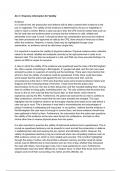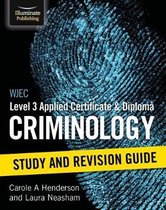AC 3.1 Examine information for Validity
Evidence
In a criminal trial, the prosecution and defence will be able to present their evidence to the
jury or magistrate. The validity of that evidence is determined by the jury or magistrate in
order to reach a verdict. Before a case can go to trial, the CPS must do certain tests such as
the full code test and evidence tests to ensure that the evidence is valid, reliable and
admissible to be used in court. It should be taken into consideration that once the evidence
has been processed and approved as valid by the CPS, there should in theory be no flaws
within the evidence. However, in theory, flaws may be highlighted through cross
examination, so evidence cannot be valid every single time.
It is important to examine the validity of physical evidence. Physical evidence when collected
needs to be stored, labelled and analysed correctly by the right personnel in order to be
deemed valid. This can then be analysed in a lab, and DNA can show accurate findings of a
person as DNA is unique to everyone.
A case in which the validity of the evidence was questioned was the case of the Birmingham
Six. After a series of bombings in Birmingham, 21 people had died, and Six Irish men were
arrested by police on suspicion of carrying out the bombings. There were many factors that
all link to how the validity of evidence could be questioned. Firstly, there could have been
some biases that the police had against the six men as they were Irish, and the
circumstances at the time in 1974 were that there were some tensions between Ireland and
England and the increasing threat of terrorism. It was found that the police were
discriminatory to the six men due to them being irish, and this included beating them, forcing
them to confess to being guilty, humiliating them, etc. The only evidence that the police had
found on the six men was that they had found ‘jelly’ on their hands, which linked to
explosives used by the IRA. Furthermore, the police had coerced the six men to confess to
false confessions, and this meant that the men were arrested and charged. This case
highlights how the evidence needs to be thoroughly checked and needs to be valid before a
case can go to court. This is because it may lead to inconsistencies and miscarriages of
justice if evidence is misleading and inaccurate. In my opinion, I believe that the evidence in
the Birmingham Six case was not enough to convict them, and more evidence should have
been gathered to fairly try them. Furthermore, the misconduct from the police also questions
the validity of the evidence as the men were forced into confessions, and had no other
choice other than to receive physical abuse from the police.
It is also important to examine the validity of testimonial evidence from eyewitnesses. This is
crucial as eyewitness testimony can be powerful in court and aid the prosecution or defence
in stabilising their side and swaying the jury opinion and ultimately verdict. However, the
validity of eyewitness testimony may be overturned when new compelling evidence such as
DNA evidence comes out, which is more reliable and accurate. This is further highlighted
through the study of Loftus, who found that a witness's memory and their recall of certain
events may be different due to many factors such as: time of day, whether they discussed
the case with others, how long ago it was, how it was questioned in court. Furthermore,
eyewitnesses may have been affected by a ‘weapon focus’ in which they focus more on the
weapon and not of their surrounding, the victims and the offender, etc
, In the brief, the physical evidence that was collected by the forensics team was not properly
secured in evidence bags due to being rushed by the police officers. The evidence was not
sealed and this information was not known to the police. This leads to the accuracy of the
evidence being misleading as there could have been a chance for contamination of the
evidence as it was not properly sealed. The forensics team should have been more careful
and should have sealed the evidence up. Furthermore, the police are at fault as they were
rushing the forensics team, and this circumstance also could have led to the forensics team
missing vital evidence, or further risking even more contamination of the evidence.
Judgements
Certain judgements may affect the validity of a case, and this may be the judgements of
judges, juries, magistrates, etc. Judgements may be made due to unintentional biases,
unconscious stereotyping, political biases, or incorrect ruling. This means that verdicts may
be less fair and could lead to miscarriages of justice if the wrong judgements are made. It is
crucial that there are no biases towards the prosecution and defender to ensure that the trial
is fair, however studies have shown that unconscious and unintentional biases can happen
in cases. For example, race can play a part in biases, and a study done by Plant and Peruch
found that in video game similar lions, police officers were more likely to shoot unarmed
black people rather than unarmed white people. Furthermore, other studies have found that
judges and death penalty lawyers may also have some biases against black people. Another
factor is gender, and some judgments made may not be valid as some biases against
gender may affect victims. In the study done by Ellison and Munro, it was found that victims
who did not show emotional responses or did not have any signs of physical injury meant
that juries were more likely to find not guilty verdicts. Furthermore, unconscious biases
towards the types of victims may mean that victims do not get a fair trial due to stereotyping
and wrongful judgements.
When inquests are made, there are some questions about the judgements that were made
on the case which may have not been valid which caused the inquest to be held. If there has
been a death due to the actions of a public organisation, such as the police, the public
organisation will receive state funded legal support, however bereaved families of the victims
will not receive such support. A pressure group called ‘inquest’ has made it their goal to get
fair trials for victims who have suffered from institutional bias, as it can be difficult for families
to challenge a verdict that has been invalid.
A case in which the families have had to challenge the verdict and judgments as they were
believed to be invalid was the Hillsborough Disaster. The Hillsborough Disaster killed 97
people and injured many others when at a football game, a human crush occurred due to
many different factors. There were two inquiries made by the families of the victims against
Duckenfield and argued that it was his fault that the gates did not open in time. The first
inquest determined that no officers were at fault and no charges were placed against them,
the deaths had been accidental but police acknowledged they were a mistake, and that all of
the deaths had occurred at 3:15 after the emergency service arrived. In 2000, the families of
the victims privately prosecuted Duckenfield, however the jury could not reach a verdict,
even though Duckenfield had lied about the deaths. In 2009, the government established the
Hillsborough Independent Panel, and a report was published which found that: there was a
lack of control, 41 people may have survived if emergency services arrived sooner, a police
cover up had altered 116 statements to remove any negative comments on their role, and





